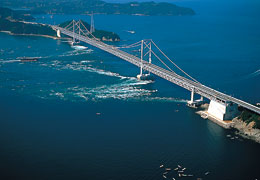Farms and Cities
The Japanese archipelago has been populated for tens of thousands of years. The Jomon culture developed about 13,000 years ago, after the last ice age. During the Jomon period, forests covered even the plains, except where naturally occurring fires burned off patches of tree cover. Food came mainly from fishing, hunting deer and bears, catching rabbits and small birds, and gathering shellfish and tree seeds. Then, more than 3,000 years ago, rice-growing techniques were introduced from the continent. This ushered in the Yayoi culture, which spread gradually from the western part of the archipelago, changing lifestyles and production methods.
Almost 2,000 years ago, a ruling class began wielding power over local areas, and their presence is still seen by their huge kofun tombs. This period was followed by a time of city planning in the Kansai area, most notably for the capitals of Heijokyo (Nara) and Heiankyo (Kyoto). The jori system of dividing land into regular plots facilitated rice cultivation. Architectural styles were introduced from the continent, but wood was the main construction material because of the ample supply of trees. Buddhism spread among the people without supplanting the older Shinto beliefs.
During most of the Edo period (1603-1867), contact with other countries was basically prohibited under national seclusion (sakoku) policies. A unique popular culture and commercial tradition flourished in major cities like Edo (present-day Tokyo) and Osaka. Feudal lords called daimyo were given authority in han domains throughout the country, and their newly constructed castles and castle towns became centers of commerce and religion. Moving to a different area was generally forbidden, leading to the further development of local dialects and folk culture. The majority of people lived in farming villages. On steep slopes, terraced fields for rice and vegetables were constructed. Roads had to wind their way around small plots of land. Almost all agriculture was by hand, with some labor supplied by oxen in the west and horses in the east. The diet included plenty of seafood but no beef, pork or mutton. Pastureland was almost unknown.
Modernization
In 1853, the American navy's "black ships" arrived, demanding that the Shogunate end national seclusion and open the country to foreign trade. The doors opened, leading the way to the Meiji Restoration of 1868. The city of Edo, built around Edo Castle, changed its name to Tokyo ("Eastern Capital") and became the capital of a nation rushing along the Western track to modernization. Soon after, the first train began running in 1872, and the rail network quickly expanded, with many tunnels and bridges to conquer the mountains and rivers. The government promoted education and built schools nationwide. The population was about 30 million around the time of the Meiji Restoration, but grew quickly.
By the 20th century, urbanization and industrialization were well advanced, especially in Tokyo, Yokohama, Osaka, Kobe, Nagoya and Fukuoka. Major land reclamation projects and harbor improvements were promoted. In 1964, the Shinkansen bullet train began running between Tokyo and Osaka, and this spurred even more development in the "megalopolis" transportation corridor. The Shinkansen network has since expanded into many parts of the country, and Greater Tokyo's rail transit network is the largest in the world. Some local railway lines and most tramways have been abandoned, although a few keep running for nostalgic reasons. Motor vehicles are common, an expressway network serves the entire country, and roads have been extended into the mountains too, for the tourist trade. Ultramodern buildings, many quite high, have changed the cities, but there is also a movement to enhance the traditional cityscape and its beautiful wooden buildings.![]()

